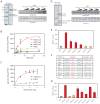Role of the polycomb protein EED in the propagation of repressive histone marks
- PMID: 19767730
- PMCID: PMC3772642
- DOI: 10.1038/nature08398
Role of the polycomb protein EED in the propagation of repressive histone marks
Abstract
Polycomb group proteins have an essential role in the epigenetic maintenance of repressive chromatin states. The gene-silencing activity of the Polycomb repressive complex 2 (PRC2) depends on its ability to trimethylate lysine 27 of histone H3 (H3K27) by the catalytic SET domain of the EZH2 subunit, and at least two other subunits of the complex: SUZ12 and EED. Here we show that the carboxy-terminal domain of EED specifically binds to histone tails carrying trimethyl-lysine residues associated with repressive chromatin marks, and that this leads to the allosteric activation of the methyltransferase activity of PRC2. Mutations in EED that prevent it from recognizing repressive trimethyl-lysine marks abolish the activation of PRC2 in vitro and, in Drosophila, reduce global methylation and disrupt development. These findings suggest a model for the propagation of the H3K27me3 mark that accounts for the maintenance of repressive chromatin domains and for the transmission of a histone modification from mother to daughter cells.
Figures





References
-
- Schuettengruber B, Chourrout D, Vervoort M, Leblanc B, Cavalli G. Genome Regulation by Polycomb and Trithorax Proteins. Cell. 2007;128:735–745. - PubMed
-
- Czermin B, et al. Drosophila enhancer of Zeste/ESC complexes have a histone H3 methyltransferase activity that marks chromosomal Polycomb sites. Cell. 2002;111:185–96. - PubMed
-
- Cao R, et al. Role of histone H3 lysine 27 methylation in Polycomb-group silencing. Science. 2002;298:1039–43. - PubMed
-
- Muller J, et al. Histone methyltransferase activity of a Drosophila Polycomb group repressor complex. Cell. 2002;111:197–208. - PubMed
Publication types
MeSH terms
Substances
Associated data
- Actions
- Actions
- Actions
- Actions
- Actions
Grants and funding
LinkOut - more resources
Full Text Sources
Other Literature Sources
Molecular Biology Databases

